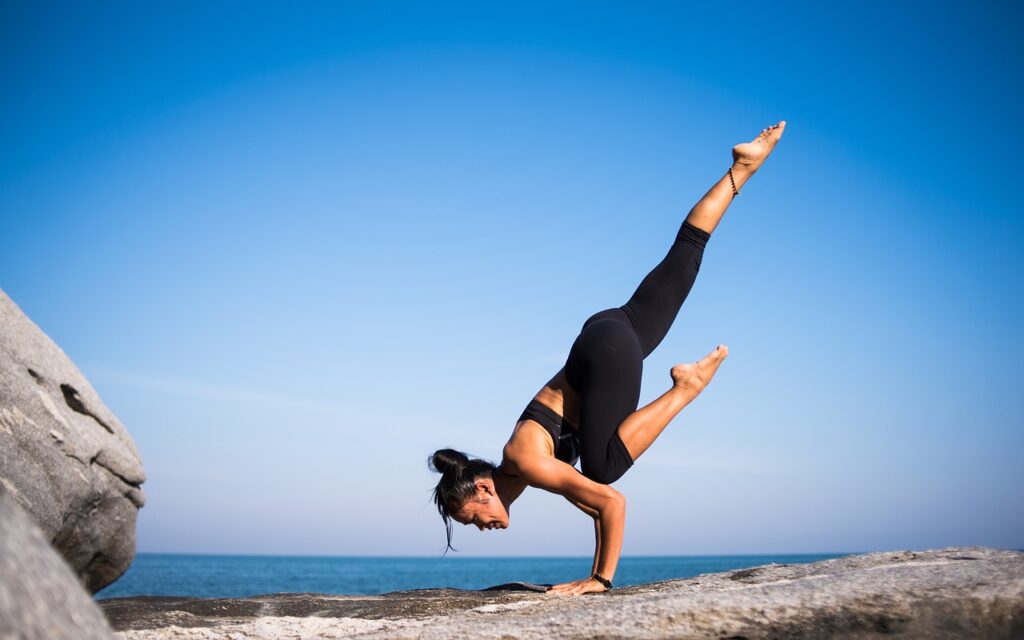Strive for balance? Learn how to achieve harmony between mind and body through yoga and meditation practices.
In the hustle and bustle of modern life, it’s easy to feel off-balance. We’re constantly juggling work, relationships, and personal well-being, often leaving us feeling mentally and physically drained. One way to regain your footing is through the practice of yoga and meditation. These ancient practices have been used for thousands of years to create harmony between the body, mind, and spirit.
So, how exactly do yoga and meditation help restore balance in our lives? Let’s dive in.
What is Balance?
Physical balance is the ability to maintain your body’s centre of gravity over your base of support. It’s what keeps you steady on your feet, allowing you to move through life without falling or tripping. Yoga plays a crucial role in enhancing this kind of balance by strengthening muscles, improving posture, and increasing flexibility (1).
Defining Mental and Emotional Balance
Mental and emotional balance involves being able to manage stress, emotions, and thoughts effectively. It’s about finding harmony between our inner world and external circumstances. Meditation is particularly useful here, as it helps to quiet the mind and cultivate a sense of inner peace (1).
Why Balance is Important for Overall Well-being
Balance isn’t just about standing on one foot. It’s a holistic concept that encompasses physical stability, mental clarity, and emotional resilience. When all three aspects are in harmony, you’re better equipped to handle life’s ups and downs with grace and confidence.
The Connection Between Yoga and Balance
Physical Balance Through Yoga Postures
Yoga is renowned for its ability to enhance physical balance. Poses like Tree Pose and Warrior III challenge your body to stay stable while improving coordination and focus.
Mental Balance Through Mindful Movements
Yoga is more than just physical exercise; it’s a mindful practice. By focusing on your breath and movements, you cultivate a deep sense of mental balance that carries over into your everyday life.
How Yoga Helps Cultivate Inner Stability
Through regular practice, yoga helps to create inner stability. The combination of breath control, physical postures, and mindfulness fosters a sense of calm that can make you feel more cantered in both body and mind.
The Role of Meditation in Achieving Balance
Meditation for Mental Clarity
Meditation is a powerful tool for clearing mental clutter. When you meditate, you train your mind to focus on the present moment, which reduces distractions and improves your ability to stay calm under pressure.
How Meditation Reduces Stress
Stress is one of the biggest disruptors of balance. Meditation reduces stress by activating the body’s relaxation response, lowering cortisol levels, and promoting a sense of inner peace (2).
Linking Meditation with Emotional Resilience
Emotional resilience is the ability to bounce back from life’s difficulties, and meditation strengthens this ability. It teaches you how to observe your thoughts and emotions without getting caught up in them, allowing you to handle challenges with more grace.
Benefits of Yoga and Meditation for Balance
- Improved Physical Coordination and Stability.
- Regular yoga practice improves muscle strength, flexibility, and coordination, all of which contribute to better physical balance.
- Enhanced Emotional Control.
- Both yoga and meditation promote emotional awareness, making it easier to manage feelings like anger, sadness, or anxiety.
- Greater Focus and Mental Sharpness.
- By focusing on breath and movement, yoga helps improve mental clarity, while meditation enhances concentration and focus over time.
- Reduced Stress and Anxiety.
- Yoga and meditation together create a calming effect that reduces stress and anxiety, contributing to a more balanced state of being.
Yoga Poses to Improve Balance
Tree Pose (Vrksasana)

Tree Pose challenges your balance by requiring you to stand on one foot while grounding yourself through your standing leg.
Warrior III (Virabhadrasana III)

This pose strengthens the legs, core, and back while improving your ability to maintain balance in a dynamic posture.
Half Moon Pose (Ardha Chandrasana)

Half Moon Pose encourages both strength and flexibility, promoting balance through the entire body.
Eagle Pose (Garudasana)

Eagle Pose improves concentration and focus, as well as physical stability, making it a powerful balance-enhancing posture.
Meditation Practices for Balance
Mindfulness Meditation
Mindfulness meditation encourages you to stay present and grounded, helping you achieve mental and emotional balance.Focused Breathing (Pranayama)
Focused breathing exercises calm the mind, reduce anxiety, and improve your ability to stay cantered.Body Scan Meditation
Body scan meditation is a great way to check in with yourself physically, allowing you to identify and release areas of tension.Visualization Techniques for Calmness
Visualization helps create a sense of calm by mentally picturing peaceful and balanced scenarios, enhancing emotional stability.
Combining Yoga and Meditation for Optimal Balance
Building a Daily Routine
Incorporating both yoga and meditation into your daily routine is the key to achieving balance. Start small and build up gradually as you become more comfortable with the practices.Integrating Mindfulness into Yoga Practice
Bringing mindfulness into your yoga practice deepens the connection between your mind and body, helping you stay present and balanced in both.The Synergy of Mind-Body Practices
Yoga and meditation work synergistically to create a harmonious balance between your mental and physical states, leading to a more cantered and peaceful life.
How to Start Your Yoga and Meditation Practice
Tips for Beginners
- Start with simple poses and short meditation sessions, gradually increasing the length and complexity as you progress.
- Setting Realistic Goals. Don’t expect perfection right away. Set realistic goals that are achievable and focus on the journey rather than the destination.
- Finding the Right Teacher or Resources. Whether through online tutorials, books, or local classes, finding the right guidance is crucial for developing a strong foundation in yoga and meditation.
Common Challenges in Achieving Balance
Physical Limitations in Yoga Practice
If you’re struggling with certain poses, don’t be discouraged. Use modifications and props to make the practice more accessible.
Mental Distractions During Meditation
It’s normal for your mind to wander during meditation. Gently bring your focus back to your breath or mantra without judgment.
How to Overcome These Challenges
Consistency is key. Keep practicing, and over time, you’ll notice improvements in both your physical balance and mental focus.
The Long-term Impact of Yoga and Meditation on Life Balance
Sustainable Mental Health Benefits
Over time, yoga and meditation contribute to improved mental health by reducing stress, enhancing emotional resilience, and promoting a sense of well-being.
Improved Work-Life Balance
By cultivating mindfulness and balance in your practice, you’re better equipped to handle the demands of work and personal life without feeling overwhelmed.Stronger Relationships Through Emotional Balance
When you’re emotionally balanced, your relationships improve because you’re more patient, understanding, and present with those around you.
Conclusion
Yoga and meditation are powerful tools for achieving both physical and mental balance. By integrating these practices into your daily routine, you’ll not only improve your physical stability but also enhance your emotional resilience and mental clarity. Whether you’re just starting or are a seasoned practitioner, the benefits of these ancient techniques are endless.
FAQs
Q1. Can I practice yoga and meditation if I’m a beginner?
A1. Absolutely! Start with beginner-friendly poses and short meditation sessions. Over time, you’ll improve with consistency.
Q2. How often should I practice yoga and meditation for balance?
A2. Aim for at least three times a week, but daily practice is ideal for optimal benefits. 20-30 minutes of practice each day will do.
Q3. What’s the best time of day to practice yoga and meditation?
A3. Morning is often the best time, as it sets a calm and focused tone for the rest of your day.
Q4. Can yoga alone improve my mental balance?
A4. While yoga helps with mental balance, combining it with meditation will yield more profound results.
Q5. How long does it take to see results from yoga and meditation?
A5. Results vary by individual, but many people start noticing benefits within a few weeks of consistent practice.
Q6. Is yoga suitable for everyone?
A6. While yoga is generally safe for most people, it’s important to consult with a healthcare professional if you have any underlying health conditions
Q7. Can yoga and meditation help with specific health conditions?
A7. Research suggests that yoga and meditation can be beneficial for a variety of health conditions, including stress, anxiety, depression, and chronic pain. However, it’s important to consult with a healthcare professional before starting a new practice.
Q8. Is it necessary to have a lot of flexibility for yoga?
A8. No, flexibility is not a requirement for yoga. Yoga can help improve your flexibility over time.
Q9. Can I meditate if I’m not good at focusing?
A9. It’s perfectly normal to experience distractions during meditation. The goal is to simply observe your thoughts without judgment and gently bring your attention back to your breath or focus.
Q10. What if I don’t have a yoga mat?
A10. You can practice yoga on a comfortable blanket or carpet.
Q11. Can children benefit from yoga and meditation?
A11. Yes, yoga and meditation can be beneficial for children of all ages. There are many child-friendly yoga classes and guided meditations available.


Pingback: Breathwork Meditation: Achieve Your Mental and Physical Wellness - Wellness Blog - Natural Healthbeing
Pingback: 10 Essential Meditation Tools to Transform Your Practice - Wellness Blog - Natural Healthbeing